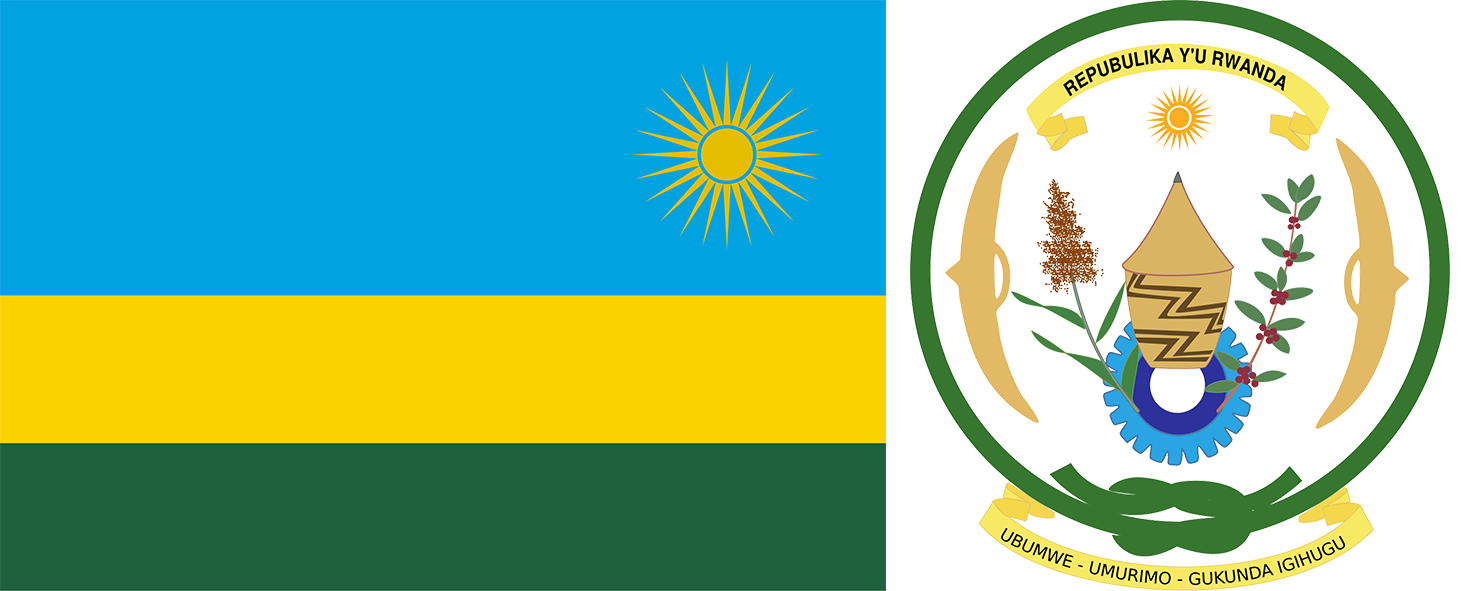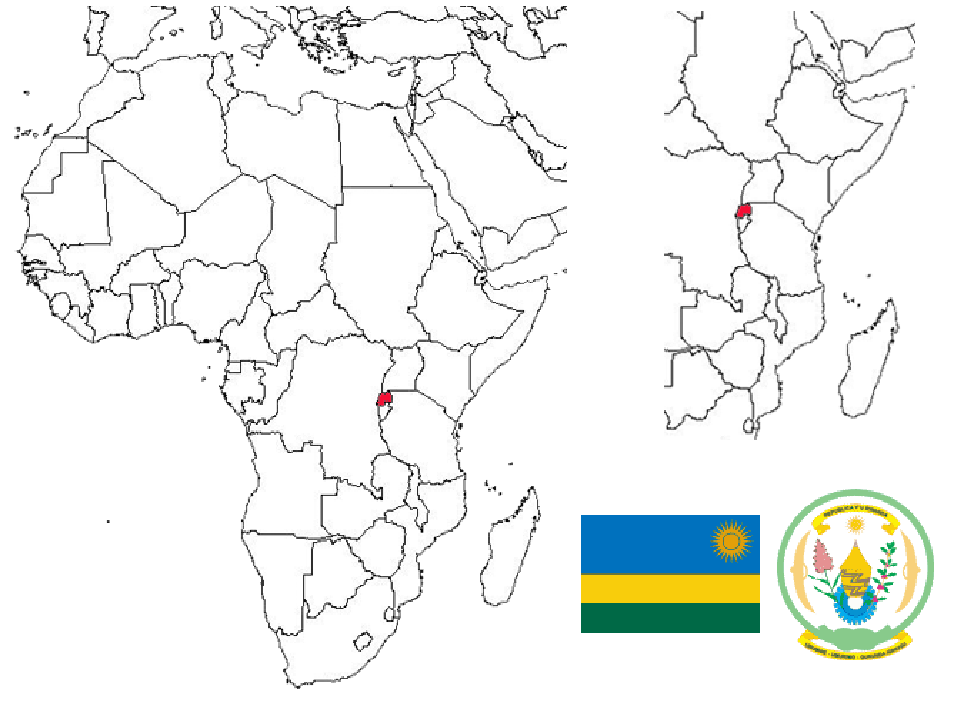FabulousFusionFood's Rwanda Recipes Home Page
 The flag of Rwanda (left) and the coat of arms of Rwanda (right).
The flag of Rwanda (left) and the coat of arms of Rwanda (right).
Welcome to the summary page for FabulousFusionFood's Rwanda recipes, part of West Africa. This page provides links to all the Rwandan recipes presented on this site, with 21 recipes in total.
Rwanda, officially: Repubulika y'u Rwanda; République du Rwanda; Republic of Rwanda is a small landlocked country in the Great Lakes region of east-central Africa. Its capital and largest city is Kigali and it attained independence from Belgium on July 1st 1962. Most Rwandans speak Kinyarwanda and the nation is roughly 84% Hutu, 15% Tutsi, and 1% Twa, with smaller minorities of South Asians, Arabs, French, British, and Belgians. The nation is some 56.5% Roman Catholic, 26% Protestant, 11.1% Adventist, and 4.6% Muslim, original beliefs 0.1%.
Rwandan food tends to be simple, made with locally-grown ingredients. Typical staples include sweet potatoes, beans, corn, peas, millet and fruit. Porridge is the traditional breakfast and meat is seldom eaten outside the cities due to its expense. Though stews are often flavoured with dried fish and meat, as is common in much of Africa. Flaked and dried fish is sometimes cooked with Chicken, yam, onions, various spices and water to prepare a flavoured stew.
These recipes, for the major part, originate in Rwanda. Otherwise they are fusion recipes with major Rwandan influences.
Rwanda, officially the Republic of Rwanda (Repubulika y'u Rwanda in Kinyarwanda; République du Rwanda in French; Jamhuri ya Rwanda in Swahili), is a landlocked country in the Great Rift Valley of East Africa, where the African Great Lakes region and Southeast Africa converge. Located a few degrees south of the Equator, Rwanda is bordered by Uganda, Tanzania, Burundi, and the Democratic Republic of the Congo. It is highly elevated, giving it the sobriquet 'land of a thousand hills' (French: pays des mille collines), with its geography dominated by mountains in the west and savanna to the southeast, with numerous lakes throughout the country. The climate is temperate to subtropical, with two rainy seasons and two dry seasons each year. It is the most densely populated mainland African country; among countries larger than 10,000 km2, it is the fifth-most densely populated country in the world. Its capital and largest city is Kigali.
 The image above shows Rwanda (in red) in relation to Africa (left) and
The image above shows Rwanda (in red) in relation to Africa (left) and
East Africa (right) the flag and arms of Rwanda are shown, inset.Hunter-gatherers settled the territory in the Stone and Iron Ages, followed later by Bantu peoples. The population coalesced first into clans, and then into kingdoms. In the 15th century, one kingdom, under King Gihanga, managed to incorporate several of its close neighbor territories establishing the Kingdom of Rwanda. The Kingdom of Rwanda dominated from the mid-eighteenth century, with the Tutsi kings conquering others militarily, centralising power, and enacting unifying policies. In 1897, Germany colonized Rwanda as part of German East Africa, followed by Belgium, which took control in 1916 during World War I. Both European nations ruled through the Rwandan king and perpetuated a pro-Tutsi policy. The Hutu population revolted in 1959. They massacred numerous Tutsi and ultimately established an independent, Hutu-dominated republic in 1962 led by President Grégoire Kayibanda. A 1973 military coup overthrew Kayibanda and brought Juvénal Habyarimana to power, who retained the pro-Hutu policy. The Tutsi-led Rwandan Patriotic Front (RPF) launched a civil war in 1990. Habyarimana was assassinated in April 1994. Social tensions erupted in the Rwandan genocide that spanned one hundred days. The RPF ended the genocide with a military victory in July 1994.
Rwanda has been governed by the RPF as a de facto one-party state since 1994 with former commander Paul Kagame as President since 2000. The country has been governed by a series of centralized authoritarian governments since precolonial times. Although Rwanda has low levels of corruption compared with neighbouring countries, it ranks among the lowest in international measurements of government transparency, civil liberties and quality of life. The population is young and predominantly rural; Rwanda has one of the youngest populations in the world. Rwandans are drawn from just one cultural and linguistic group, the Banyarwanda. However, within this group there are three subgroups: the Hutu, Tutsi and Twa. The Twa are a forest-dwelling pygmy people and are often considered descendants of Rwanda's earliest inhabitants. Christianity is the largest religion in the country; the principal and national language is Kinyarwanda, spoken by native Rwandans, with English, French and Swahili serving as additional official foreign languages.
The Republic of Rwanda was named by 1834, Ruanda, probably via French, named for indigenous people there, whose word for themselves is of unknown origin. The spelling with -w- seems to have predominated after c. 1970.
Rwanda, officially: Repubulika y'u Rwanda; République du Rwanda; Republic of Rwanda is a small landlocked country in the Great Lakes region of east-central Africa. Its capital and largest city is Kigali and it attained independence from Belgium on July 1st 1962. Most Rwandans speak Kinyarwanda and the nation is roughly 84% Hutu, 15% Tutsi, and 1% Twa, with smaller minorities of South Asians, Arabs, French, British, and Belgians. The nation is some 56.5% Roman Catholic, 26% Protestant, 11.1% Adventist, and 4.6% Muslim, original beliefs 0.1%.
Rwandan food tends to be simple, made with locally-grown ingredients. Typical staples include sweet potatoes, beans, corn, peas, millet and fruit. Porridge is the traditional breakfast and meat is seldom eaten outside the cities due to its expense. Though stews are often flavoured with dried fish and meat, as is common in much of Africa. Flaked and dried fish is sometimes cooked with Chicken, yam, onions, various spices and water to prepare a flavoured stew.
These recipes, for the major part, originate in Rwanda. Otherwise they are fusion recipes with major Rwandan influences.
Rwanda, officially the Republic of Rwanda (Repubulika y'u Rwanda in Kinyarwanda; République du Rwanda in French; Jamhuri ya Rwanda in Swahili), is a landlocked country in the Great Rift Valley of East Africa, where the African Great Lakes region and Southeast Africa converge. Located a few degrees south of the Equator, Rwanda is bordered by Uganda, Tanzania, Burundi, and the Democratic Republic of the Congo. It is highly elevated, giving it the sobriquet 'land of a thousand hills' (French: pays des mille collines), with its geography dominated by mountains in the west and savanna to the southeast, with numerous lakes throughout the country. The climate is temperate to subtropical, with two rainy seasons and two dry seasons each year. It is the most densely populated mainland African country; among countries larger than 10,000 km2, it is the fifth-most densely populated country in the world. Its capital and largest city is Kigali.
 The image above shows Rwanda (in red) in relation to Africa (left) and
The image above shows Rwanda (in red) in relation to Africa (left) andEast Africa (right) the flag and arms of Rwanda are shown, inset.
Rwanda has been governed by the RPF as a de facto one-party state since 1994 with former commander Paul Kagame as President since 2000. The country has been governed by a series of centralized authoritarian governments since precolonial times. Although Rwanda has low levels of corruption compared with neighbouring countries, it ranks among the lowest in international measurements of government transparency, civil liberties and quality of life. The population is young and predominantly rural; Rwanda has one of the youngest populations in the world. Rwandans are drawn from just one cultural and linguistic group, the Banyarwanda. However, within this group there are three subgroups: the Hutu, Tutsi and Twa. The Twa are a forest-dwelling pygmy people and are often considered descendants of Rwanda's earliest inhabitants. Christianity is the largest religion in the country; the principal and national language is Kinyarwanda, spoken by native Rwandans, with English, French and Swahili serving as additional official foreign languages.
The Republic of Rwanda was named by 1834, Ruanda, probably via French, named for indigenous people there, whose word for themselves is of unknown origin. The spelling with -w- seems to have predominated after c. 1970.
Food and Cuisine:
The cuisine of Rwanda is based on local staple foods produced by subsistence agriculture such as bananas, plantains (known as ibitoke), pulses, sweet potatoes, beans, and cassava (manioc). Many Rwandans do not eat meat more than a few times a month. For those who live near lakes and have access to fish, tilapia is popular. The potato, thought to have been introduced to Rwanda by German and Belgian colonialists, is very popular. Ugali, locally known as Ubugari (or umutsima) is common, a paste made from cassava or maize and water to form a porridge-like consistency that is eaten throughout the African Great Lakes. Isombe is made from mashed cassava leaves and can be served with dried fish, rice, ugali, potatoes etc. Lunch is usually a buffet known as mélange, consisting of the above staples and sometimes meat. Brochettes are the most popular food when eating out in the evening, usually made from goat but sometimes tripe, beef, or fish.The alphabetical list of all the Rwandan recipes on this site follows, (limited to 100 recipes per page). There are 21 recipes in total:
Page 1 of 1
| Amandazi Origin: Rwanda | Igitoke Origin: Rwanda | Rwanda Pelau Seasoning Origin: Rwanda |
| Bananas with Split Green Peas Origin: Rwanda | Isombe Origin: Rwanda | Rwandan Agatogo (Rwandan Beans with Cassava) Origin: Rwanda |
| Brochettes de Boeuf (Beef Kebabs) Origin: Rwanda | Kachumbari Origin: Rwanda | Rwandan Beef Stew Origin: Rwanda |
| Coconut Peas Origin: Rwanda | Peanut Nougat Origin: Rwanda | Rwandan Chicken Origin: Rwanda |
| Goat Brochettes Origin: Rwanda | Purée d'Aubergines (Aubergine Purée) Origin: Rwanda | Rwandan Porridge Origin: Rwanda |
| Ibirayi Bisize (Rwandan Fried Potatoes) Origin: Rwanda | Purée d'aubergines à la Rwandaise (Rwandan Aubergine Paste) Origin: Rwanda | Rwandan Ugali Origin: Rwanda |
| Igisafuliya (Chicken Plantain and Vegetable Stew) Origin: Rwanda | Rwanda Goat Pelau Origin: Rwanda | Ubugali (Cassava Porridge) Origin: Rwanda |
Page 1 of 1